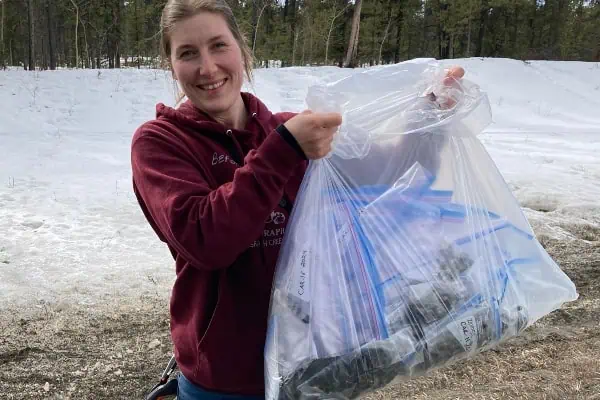The light returns to the Yukon long before the heat and we’re still in the prime season of huge oscillations in temperature between day and night. Mornings dawn crisp – but early – and as of yet we feel no compulsion to head outside until it warms a little. Midafternoon brings mud and even t-shirt weather and long evenings have us out working in the yard until good gracious it’s after nine and I should probably make supper.
In the Klondike our thawing ground is still a ways from yielding anything green and growing, however, so as the light wakes us from our dormant winter state and gets our noses sniffing about for something fresh to eat, I start sowing flats of greens to get us off to a good start.
Seeds never cease to amaze me. I’ve been watching our tomato seedlings with awe, not to mention eggplants, peppers, basil, celery and a host of flowers that fill the greenhouse shelves.
That those tiny capsules of genetic material and a little hit of nutrition contain the raw materials for the leafy creatures that are quickly outgrowing their containers blows me away.
I look over a flat of plants originating from seeds I smeared across a piece of paper last fall and note that the uniformity seen from a distance dissolves into diversity as I peer in closer. This one has a truncated first true leaf, that a knobbly bit of stem just above the seed leaves. They show a collective curve towards one side of the tray in evidence of their orientation towards the sun yesterday, a tropism that can be reversed or accentuated today depending on how they are placed.
As I was sorting seeds in my early-March enthusiasm for the onset of spring I set aside many of the ancient packets that have been replaced with newer ones in a bin of “early greens.” Instead of keeping them another year and wondering if they yet have life in them, I’ve sown them en masse in large, open flats to provide our first salads.
First the seeds that like to be below the surface, then a sprinkling of fine soil and finally the lettuce and other light-loving seeds. Anything that doesn’t germinate will be overwhelmed by what does, and I will have a cleaner slate for next year’s seed orders.
I listened to a CBC podcast on seed banks recently that reminded me both of the great lengths of time that seeds can remain viable, and also of the importance of “living” or “revolving” banks when it comes to this kind of live material – instead of being stored for perpetuity seeds take kindly to being grown out and saved again, a practice which has been carried out on this continent by First Nations for an awfully long time, more recently by European settlers bringing with them seeds from the Old Country, then by the back-to-the-landers in the ’60s and ’70s, who we have to thank for many of our seed exchanges.
Most recently the trend towards appreciating local has inspired a new wave of seed savers who exchange seeds and learn techniques that are as old as agriculture, growing in vertical gardens in apartments and community-run plots in urban centers as often as on rural farms and acreages.
Soon enough we will be getting our first crops in the gardens outside, but until then these little trays of greens will get a weekly haircut to provide us with our first hit of comestible spring. Happy planting!
Five Things To Do With Old Seeds
1) Run a germination test by placing 10 seeds in a damp paper towel, pack into a Ziploc bag, and set in a warm place.
2) Donate them to a seed library, like the one at Energy, Mines and Resources.
3) Participate in a local seedy Saturday/Sunday.
4) Start your own seed exchange with friends and neighbours.
5) Make a literal mixed bag and sow thickly for your first salad of spring.
6) When all else fails, make art!




